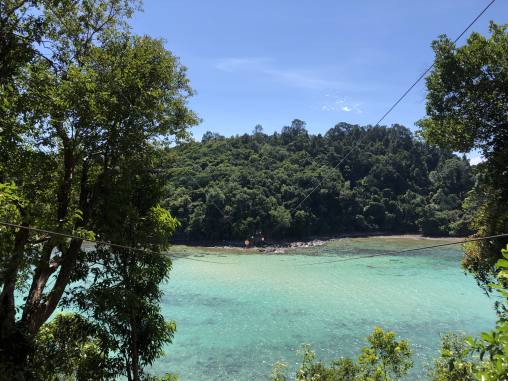For my final post, I’ve decided to only include pictures from Sun Yat-sen Memorial Hall. since it was very close to my apartment in Taipei and I passed through it every day. On my last night in Taiwan, I went there to watch the sunset and the flag-lowering ceremony, which seemed a fitting ending to my semester abroad. Keeping that in mind, I wanted to use my final post to reflect on my experience and what it’s taught me.

Palm Trees alongside the lake that’s within the memorial grounds
I ultimately decided to study abroad in Taiwan because I was drawn to the relative independence of the program and its allure towards Chinese learners who already had several years of language study under their belt. In these two regards, the program lived up to my expectations. Given the structure of the classes being once a week for 3 hour sessions, I found myself with a great deal of free time even when taking 5 classes overall. For this reason I would not recommend the program to those only at the basic or intermediate levels yet serious about learning Chinese, unless they opt for the Intensive Mandarin track and are willing to stay throughout the entirety of the semester (from September to mid-January). The vast majority of my learning came from immersion outside of the classroom, which is easier for higher levels. In fact, any study abroad program – especially one with as much autonomy as this – is as intensive and immersive as you make it (in terms of language learning). This became far more apparent to me during my time in Taiwan.

The main memorial hall building. Inside is a large statue of Dr. Sun Yat-sen somewhat reminiscent of the Lincoln memorial.
One thing I was surprised to find was just how different several aspects of living in Taiwan versus Mainland China were. Though China in the past two to three decades has undergone rapid modernization and development, it did not seem as widespread and, frankly, Westernized as Taiwan. This could be for any number of reasons, be it comparative size, governance and policies, etc., but Taipei was a city with all kinds of Western influences present. I was even more surprised by the pervasive Japanese influence. Having just studied in Northeast China the summer before, it was immediately apparent how markedly different the sentiment towards the Japanese was in that region versus in Taiwan. The latter seems to welcome cultural, technological, and other influences from Japan quite openly, while I noticed a bit of animosity still lingering in China in some regards. Learning about these distinctions and attempting to unwrap cultural identities within Taiwan, China, and Japan was a major part of my experience. I also learned far more about China than I had expected, which is invaluable for me as a Chinese Studies major.

A scroll featuring ancient Chinese characters. Rotating art and culture exhibits are located inside the 2nd and 3rd floors of the memorial.
No matter where you go, studying abroad will place you in a new environment completely different from Richmond and teach you a lot about yourself in the process. I learned how to cook for myself and plan my meals entirely on my own, though in a grander sense I also learned how to navigate in unknown and unpredictable environments and became a far better traveler. This is my 3rd study abroad experience, and each one has taught me something different about the host country and about myself. On my first two trips, I was the only student from UR, and on this one there was only one classmate and close friend also in the program. While not being around many other students from UR is not at all necessary to have a meaningful and impactful experience, it nonetheless pushed me to further breach my comfort zone and establish new friendships and connections along the way that I otherwise might not have sought out as openly. Studying abroad isn’t all easy and things will undoubtedly be frustrating and difficult, but it’s something totally worth it if given the opportunity, regardless of it’s whether its for academic reasons or to experience a new culture.

After sunset, I stumbled upon soldiers performing a ceremonial flag lowering ceremony. I am not sure if this is done daily, but it was a nice last-memory of the memorial.
I want to say thank you for reading my posts throughout the semester and allowing me to share different aspects of my abroad experience. I’d encourage people to look into Taipei and other less-mainstream study abroad options because living abroad for 3-4 months is not something most have the opportunity to do and choosing to immerse yourself in a completely different culture has lots of amazing benefits. I’m excited to take my perspective back to Richmond and hear all about others’ time abroad as well.
Bryan



 Posted by bryanintaipei
Posted by bryanintaipei 





























